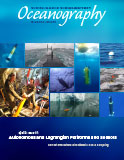Anctil, F., M.A. Donelan, G.Z. Foristall, K.E. Steele, and Y. Ouelle. 1993. Deep water field evaluation of the NDBC-SWADE 3-m discus directional buoy. Journal of Atmospheric and Oceanic Technology 10:97–112.
Bailleul, F., M. Authier, S. Ducatez, F. Roquet, J.B. Charrassin, Y. Cherel, and C. Guinet. 2010. Looking at the unseen: Combining animal bio-logging and stable isotopes to reveal a shift in the ecological niche of a deep-diving predator. Ecography 33:709–719, https://doi.org/10.1111/j.1600-0587.2009.06034.x.
Berrisford, P., D.P. Dee, P. Poli, R. Brugge, K. Fielding, M. Fuentes, P.W. Kållberg, S. Kobayashi, S. Uppala, and A. Simmons. 2011. The ERA-Interim Archive Version 2.0. ERA Report Series, European Centre for Medium Range Weather Forecasts, Reading, UK, 23 pp.
Burgess, W.C. 2000. The bioacoustic probe: A general-purpose acoustic recording tag. Journal of the Acoustical Society of America 108(5):2,583–2,583, https://doi.org/10.1121/1.4743598.
Burgess, W.C., P. Tyack, B. Le Boeuf, and D.P. Costa. 1998. A programmable acoustic recording tag and first results from free-ranging northern elephant seals. Deep Sea Research Part II 45:1,327–1,351, https://doi.org/10.1016/S0967-0645(98)00032-0.
Cazau, D., J. Bonnel, J. Jouma’a, Y. Le Bras, and C. Guinet. 2017. Measuring the marine soundscape of the Indian Ocean with southern elephant seals used as acoustic gliders of opportunity. Journal of Atmospheric and Oceanic Technology 34:207–223, https://doi.org/10.1175/JTECH-D-16-0124.1.
Charrassin, J.B., M. Hindell, S.R. Rintoul, F. Roquet, S. Sokolov, M. Biuw, D. Costa, L. Boehme, P. Lovell, R. Coleman, and others. 2008. Southern Ocean frontal structure and sea-ice formation rates revealed by elephant seals. Proceedings of the National Academy of Sciences of the United States of America 105:11, 634–11, 639, https://doi.org/10.1073/pnas.0800790105.
Daniault, N.P., P. Blouch, and F.X. Fusey. 1985. The use of free-drifting meteorological buoys to study winds and surface currents. Deep Sea Research Part A 32(1):107–113, https://doi.org/10.1016/0198-0149(85)90020-2.
Day, L., J. Joumaa, J. Bonnel, and C. Guinet. 2017. Acoustic measurements of post-dive cardiac responses in southern elephant seals (Mirounga leonina) during surfacing at sea. Journal of Experimental Biology 220:1,626–1,633, https://doi.org/10.1242/jeb.146928.
Dee, D.P., S.M. Uppala, and A.J. Simmons. 2011. The ERA-Interim Reanalysis: Configuration and performance of the data assimilation system. Quarterly Journal of the Royal Meteorological Society 137:553–597, https://doi.org/10.1002/qj.828.
Earle, M.D. 1996. Nondirectional and Directional Wave Data Analysis Procedures. National Data Buoy Center Technical Document 96-01. National Oceanic and Atmospheric Administration, US Department of Commerce, Stennis Space Center, MS, USA, 43 pp., http://www.ndbc.noaa.gov/wavemeas.pdf.
Earle, M.D., and L.E. Borgman. 1999. Statistical intercomparison of ocean wave parameters. Paper presented at the Third Conference on Coastal Atmospheric and Oceanic Prediction and Processes, November 3–5, 1999, New Orleans, LA, American Meteorological Society.
Génin, A., G. Richard, J. Jouma’a, B. Picard, N. El Ksabi, J. Vacquié-Garcia, and C. Guinet. 2015. Characterization of postdive recovery using sound recordings and its relationship to dive duration, exertion, and foraging effort of southern elephant seals (Mirounga leonina). Marine Mammal Science 31:1,452–1,470, https://doi.org/10.1111/mms.12235.
Gilhousen, D.B. 2007. Improvements in National Data Buoy Center measurements. National Oceanic and Atmospheric Administration, http://www.ndbc.noaa.gov/improvements.shtml.
Guinet, C., J. Vacquié-Garcia, B. Picard, G. Bessigneul, Y. Le Bras, A.C. Dragon, M. Viviant, J.P.Y. Arnould, and F. Bailleul. 2014. Southern elephant seal foraging success in relation to temperature and light conditions: Insight into prey distribution. Marine Ecology Progress Series 499:285–301, https://doi.org/10.3354/meps10660.
Guinet, C., X. Xing, E. Walker, P. Monestiez, S. Marchand, B. Picard, T. Jaud, M. Authier, C. Cotté, A.C. Dragon, and others. 2013. Calibration procedures and first dataset of Southern Ocean chlorophyll profiles collected by elephant seals equipped with a newly developed ctd-fluorescence tags. Earth Systems Science Data 5:15–29, https://doi.org/10.5194/essd-5-15-2013.
Hashimoto, N., and K. Konbune. 1988. Directional spectrum estimation from a Bayesian approach. Coastal Engineering Proceedings 1:62–7.
Hindell, M.A. 1991. Some life-history parameters of a declining population of southern elephant seals, Mirounga leonina. Journal of Animal Ecology 60:119–134.
Irish, J.D., D.W. Fredriksson, and J. Ahern. 2002. Estimating Significant Wave Height and Dominate Wave Period from Buoy Mounted, Strap-Down Accelerometer Observations. Technical report, Woods Hole Oceanographic Institution, 24 pp.
Lin, Y.-P., C.-J. Huang, S.-H. Chen, D.-J. Doong, and C.C. Kao. 2017. Development of a GNSS buoy for monitoring water surface elevations in estuaries and coastal areas. Sensors 17(1):172, https://doi.org/10.3390/s17010172.
Rajeswari, V., and L.P. Suresh. 2015. Investigation and control of principal axes of aircraft using robust method. In Power Electronics and Renewable Energy Systems. C. Kamalakannan, L. Suresh, S. Dash, and B. Panigrahi, eds, Lecture Notes in Electrical Engineering, vol. 326, Springer, New Delhi, https://doi.org/10.1007/978-81-322-2119-7_152.
Richard, G., J. Vacquié-Garcia, J. Jouma’a, B. Picard, A. Génin, J.P.Y. Arnould, F. Bailleul, and C. Guinet. 2014. Variation in body condition during the post-moult foraging trip of southern elephant seals and its consequences on diving behaviour. Journal of Experimental Biology 217:2,609–2,619, https://doi.org/10.1242/jeb.088542.
Ropert-Coudert, Y., and R.P. Wilson. 2005. Trends and perspectives in animal-attached remote sensing. Frontiers in Ecology and the Environment 3:437–444, https://doi.org/10.1890/1540-9295(2005)003[0437:TAPIAR]2.0.CO;2.
Roquet, F., G. Williams, M.A. Hindell, R. Harcourt, C. McMahon, C. Guinet, J.-B. Charrassin, G. Riverdin, L. Boehme, P. Lovell, and M. Fedak. 2014. A southern Indian Ocean database of hydrographic profiles obtained with instrumented elephant seals. Scientific Data 1:140028, https://doi.org/10.1038/sdata.2014.28.
Rutz, C., and G.C. Hays. 2009. New frontiers in biologging science. Biology Letters 5:289–292, https://doi.org/10.1098/rsbl.2009.0089.
Stopa, J.E., and K.F. Cheung. 2014. Intercomparison of wind and wave data from the ECMWF Reanalysis Interim and the NCEP Climate Forecast System Reanalysis. Ocean Modelling 75:65–83, https://doi.org/10.1016/j.ocemod.2013.12.006.
Treasure, A.M., F. Roquet, I.J. Ansorge, M.N. Bester, L. Boehme, H. Bornemann, J.-B. Charrassin, D. Chevallier, D.P. Costa, M.A. Fedak, and others. 2017. Marine Mammals Exploring the Oceans Pole to Pole: A review of the MEOP consortium. Oceanography 30(2):132–138, https://doi.org/10.5670/oceanog.2017.234.
Williams, G.D., L. Herraiz-Borreguero, F. Roquet, T. Tamura, K.I. Ohshima, Y. Fukamaic, A.D. Fraser, L. Gao, H. Chen, C.R. McMahon, and others. 2016. The suppression of Antarctic Bottom Water formation by melting ice shelves in Prydz Bay. Nature Communications 7:12577, https://doi.org/10.1038/ncomms12577.

